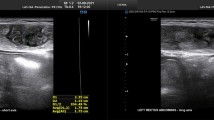Abstract
Muscle herniations are rare and most reported cases involve muscles of the lower leg. We use a case of muscle herniation involving the semimembranosus muscle, presenting as a painful mass in an adolescent male after an unspecified American football injury, to highlight a simple concept of muscle biomechanics as it pertains to muscle hernia(s): decreased traction upon muscle fibers can increase conspicuity of muscle herniation(s)—this allows a better understanding of the apt provocative maneuvers to employ, during dynamic ultrasound or magnetic resonance imaging, in order to maximize diagnostic yield and, thereby, limit patient morbidity related to any muscle herniation. Our patient subsequently underwent successful decompressive fasciotomy and has since returned to his normal daily activities.








Similar content being viewed by others
References
Richet. Traite d’anatomie chir. 1853; 124:(Cited by Choux).
De Maeseneer M, Shahabpour M, Lenchik L, Milants A, De Ridder F, De Mey J, et al. Distal insertions of the semimembranosus tendon: MR imaging with anatomic correlation. Skelet Radiol. 2014;43:781–91.
Goldberg HC, Comstock GW. Herniation of muscles of the legs. War Med. 1944;5:365–7.
Ihde H. On muscular hernia of the leg. Acta Chir Scand. 1929;65:97–120.
Kitchin IDRDA. Multiple muscle herniae. BMJ. 1943;1:602–3.
McMaster PE. Muscle hernia of the leg: a study of 21 cases and 38 hernias. US Nav Med Bull. 1943;41:404–9.
Mellado JM, Pérez del Palomar L. Muscle hernias of the lower leg: MRI findings. Skelet Radiol. 1999;28:465–9.
Nguyen JT, Nguyen JL, Wheatley MJ, Nguyen TA. Muscle hernias of the leg: a case report and comprehensive review of the literature. Can J Plast Surg. 2013;21:243–7.
Schaefer WB. Nontraumatic tears of the tibial fascia. Mil Surg. 1943;93:308–10.
Sherry RH. Herniation of peroneus brevis muscle: report of a case. Bull Hosp Dis. 1942; 69–72.
Simon HE, Sacchet HA. Muscle hernias of the leg: review of literature and report of twelve cases. Am J Surg. 1945;67:87–97.
Hesse Zur Frage der Radikaloperation der Hern en des Muscul tibialis anticus. (Russian orig) Ref Zentralorgan fur Chir. 1921; 271.
Harrington AC, Mellette JR. Hernias of the anterior tibialis muscle: case report and review of the literature. J Am Acad Dermatol. 1990;22:123–4.
Marques A, Brenda E, Amarante MT. Bilateral multiple muscle hernias of the leg repaired with Marlex mesh. Br J Plast Surg. 1994;47:444–6.
Zeiss J, Ebraheim NA, Woldenberg LS. Magnetic resonance imaging in the diagnosis of anterior tibialis muscle herniation. Clin Orthop Relat Res. 1989; 249–53.
Koulouris G, Connell D. Hamstring muscle complex: an imaging review. Radiographics. 2005;25:571–86.
De Smet AA. Magnetic resonance findings in skeletal muscle tears. Skelet Radiol. 1993;22:479–84.
De Smet AA, Fisher DR, Heiner JP, Keene JS. Magnetic resonance imaging of muscle tears. Skelet Radiol. 1990;19:283–6.
Govindarajan A, Inigo A. Tibialis anterior muscle hernia: a rare differential of a soft tissue tumour. BMJ Case Rep. 2015; 2015.
Yochim SE, Jose J, Clifford PD. Muscle herniation of the extremity. Am J Orthop (Belle Mead NJ). 2010;39:95–6.
Lee H-S, James M. Painful bilateral herniation of the anterior tibial muscle: a case report. Foot Ankle Int. 2006;27:552–5.
Miniaci A, Rorabeck CH. Compartment syndrome as a complication of repair of a hernia of the tibialis anterior: a case report. J Bone Joint Surg Am. 1986;68:1444–5.
Dawar AK, Dawar R, Gawri KGV. Tibialis anterior muscle hernia: a rare cause of leg pain. JCR. 2012;2:42–4.
Henning PT, Dahm DL, Smith J. Use of postexercise ultrasonography to identify a symptomatic extensor digitorum longus muscle hernia associated with running. PM R. 2009;1:1109–11.
Author information
Authors and Affiliations
Corresponding author
Ethics declarations
Conflict of interest
The authors declare that they have no conflict of interest.
Funding
None.
Rights and permissions
About this article
Cite this article
Naffaa, L., Moukaddam, H., Samim, M. et al. Semimembranosus muscle herniation: a rare case with emphasis on muscle biomechanics. Skeletal Radiol 46, 373–378 (2017). https://doi.org/10.1007/s00256-016-2553-x
Received:
Revised:
Accepted:
Published:
Issue Date:
DOI: https://doi.org/10.1007/s00256-016-2553-x




